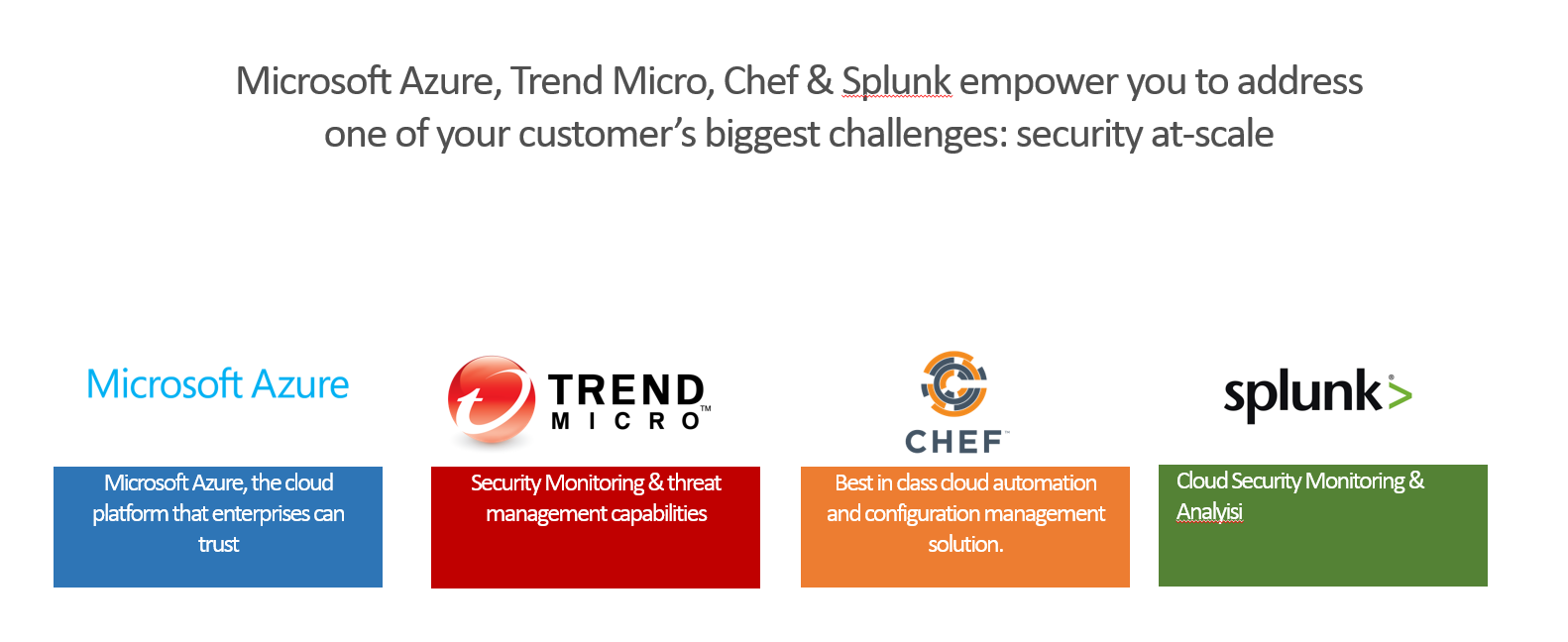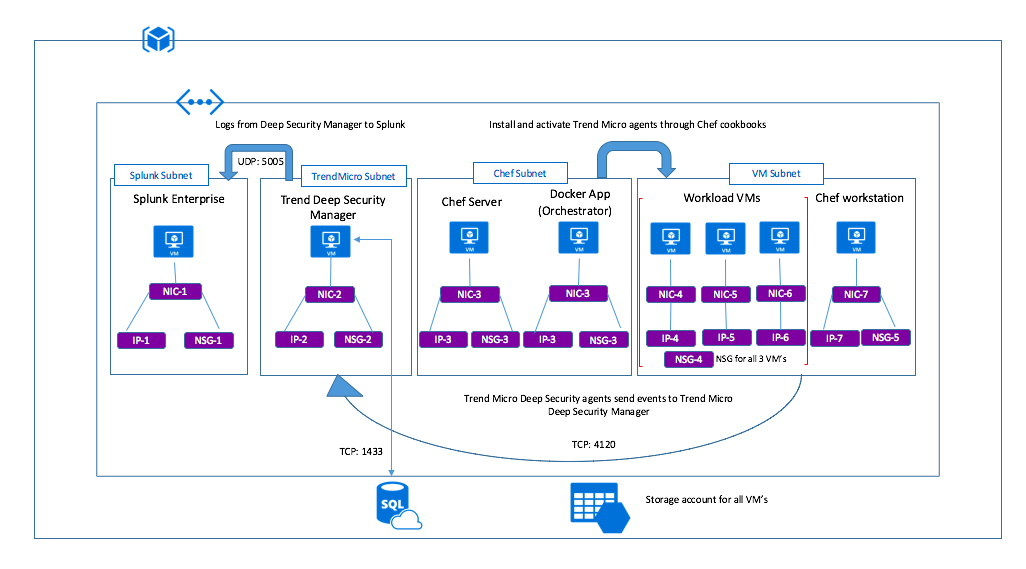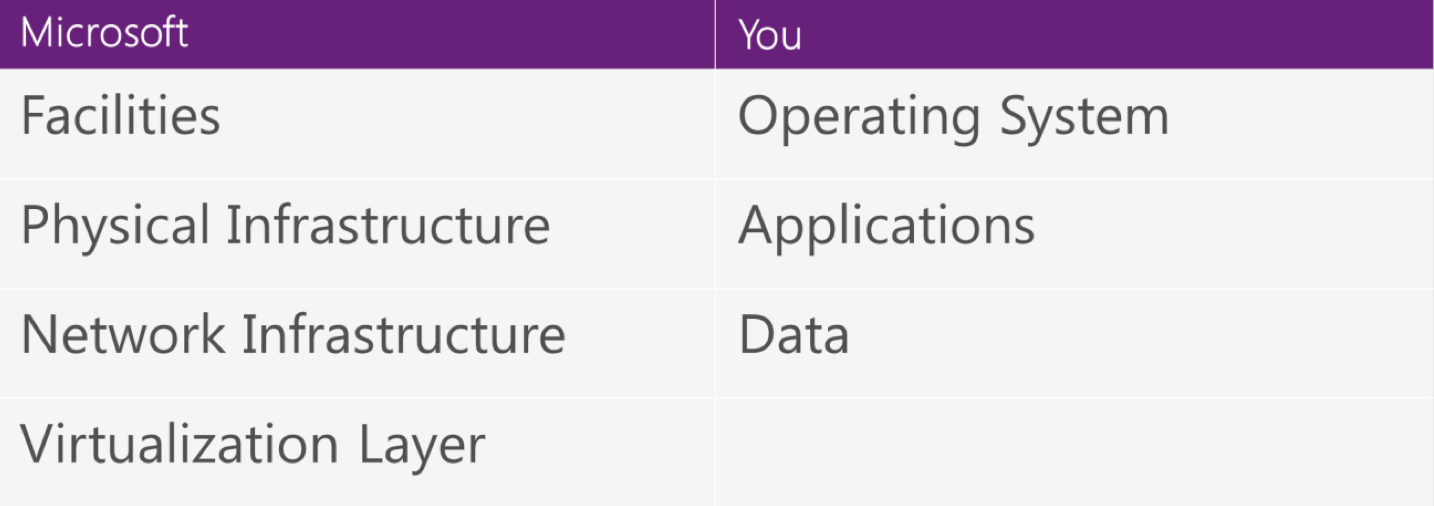

Solution Templates provide customers with a highly automated process to launch enterprise ready first and 3rd party ISV solution stacks on Azure in a pre-production environment. The Solution Template effort is complimentary to the Azure Marketplace test drive program. These fully baked stacks enable customers to quickly stand up a PoC or Piloting environments and also integrate it with their systems and customization.
Customers benefit greatly from solution templates because of the ease with which they can stand up enterprise-grade, fully integrated stacks on Azure. The extensive automation and testing of these solutions will allow them to spin up pre-production environments with minimal manual steps and customization. Most importantly, customers now have the confidence to transition the solution into a fully production-ready environment with confidence.
Cloud Security Solution Template 001 launches a security-at-scale solution stack that provides an automated provisioning, configuration and integration of Trend Micro's Deep Security product on Azure. Combined with Splunk Enterprise & Chef Automate products makes this solution ready for pre-production environments. These are intended as pilot solutions and not production ready. Please contact us if you need further info or support on this solution.
##Licenses & Costs In its current state, solution templates come with licenses built-in – there may be a BYOL option included in the future. The solution template will be deployed in the Customer’s Azure subscription, and the Customer will incur Azure usage charges associated with running the solution stack.
##Target Audience The target audience for these solution templates are IT professionals who need to stand-up and/or deploy infrastructure stacks.
- Azure Subscription - if you want to test drive individual ISV products, please check out the Azure Marketplace Test Drive Program
- Azure user account with Contributor/Admin Role
- Sufficient Quota - At least 18 Cores( with default VM Sizes)
##Solution Summary
The goal of this solution stack is to provide an automated way of managing security on existing as well as new cloud workloads at scale. Such a solution would require a centralized workload protection platform(master) to secure applications and operating systems running on Virtual Machines on Azure. It would also require an automated way of ensuring the VM's (existing as well as new) are bootstrapped to the master. This is achieved using multiple ISV products and integrating them in an automated way.

The core component of this stack is Trend Micro Deep Security Manager, which is a cloud security control platform. There are two pieces to the platform: the Deep Security Manager and the Deep Security Agents. The Manager runs centrally, and the Agents are deployed on the virtual machines you want protected. The Manager allows you to set up and customize security policy, monitor events, and deliver security rule updates. The Agent does all the heavy lifting by delivering the following controls:
- anti-malware
- web reputation (also known as content filtering)
- firewall
- intrusion prevention
- integrity monitoring
- log inspection
These controls provide much-needed security to your operating systems and applications. This lines up nicely with the way security works in the Azure Cloud, which operates under the Shared Responsibility Model. This model draws a clear line where Azure responsibility for security ends and where your responsibility begins.
TrendMicro DSM is an agents based security control platform. The agents need to be deployed and configured to integrate with the Master server. As new VM's are launched in the cloud, there needs to be an automated way of bootstrapping these agents to the master. This is a typical problem in many cloud deployments. This solution stack provides two ways of deploying the agents in a dynamic manner
- TrendMicro Azure Extension: Azure provides an extension to deploy and configure the agent on a VM.
- TrendMicro Chef Cookbooks: Configuration Management is a key aspect in configuring servers, its applications and handling security. Chef, which is a very popular configuration management solution, can be used to install and configure TrendMicro agents. Further Chef recipes can be used to manage configuration of the application and servers to ensure they fall in line with the security policies defined in Trend Micro DSM.
This solution stack implements the second option (with Chef). It deploys a Chef Automate and an automated framework that allows any new VM's to bootstrap to Chef Automate (Chef Server) as and when they get provisioned. Additionally, in order to integrate Chef Automate with Chef Nodes in an automated way, additional microservices are deployed as a set of two Docker Containers (a Node.js app and a database).
Cloud security monitoring is another critical aspect of enabling security at scale. The logs and data that is generated on the VMs can be monitored using Splunk's intelligence platform service, part of Splunk Enterprise. This solution stack also deploys the Splunk Enterprise solution and automatically integrates it with TrendMicro DSM to collect all logs and event data from the VMs.
##Reference Architecture Diagram

The diagram above provides the overall deployment architecture for this test drive. As a part of deployment the template launches the following:
- A storage account in the resource group.
- A Virtual Network with four subnets [subnet1 (Trendmicro), subnet2 (Chef & Orchestrator), Subnet3 (Splunk) & subnet4 (VM's& Workstation)].
- Trend micro vm is built from the image reference in the subnet1:
"publisher": "trendmicro",
"offer": "deep-security-vm",
"sku": "dxxn25d2v2",
"version": "latest
- Network security group(NSG1) is assigned to Network Interface (NIC 1) which is attached to TrendMicro VM. The NSG 1 rules are same as the security rules mentioned in TrendMicro section. A public IP is attached to Network interface.
- Deploy Azure SQL DB.
- Deploy Splunk VM (standalone) (size D5_V2) from image reference in subnet3:
"publisher": "splunk",
"offer": "splunk-enterprise-base-image",
"sku": "splunk-on-ubuntu-14-04-lts",
"version": "1.0.8"
- Network security group(NSG2) is assigned to Network Interface (NIC 2) which is attached to Splunk VM. The NSG 2 rules are the same as the security rules mentioned in the Splunk section. A public IP is attached to Network interface.
- Place the Splunk VM in a availability set.
- Deploy Chef Automate in Subnet2 and integrate with orchestrator. A public IP is attached to Network interface. Deploy an orchestrator service using Docker.
- Deploy 2 VMs (Linux, Windows) with bootstrap scripts to install TrendMicro agents (through extensions).
- Deploy 1 VMs (Linux) with bootstrap scripts to install Chef Agents and connect them to the server using orchestrator.
You can click the "deploy to Azure" button at the beginning of this document or follow the instructions for command line deployment using the scripts in the root of this repo.
Please refer to parameter descriptions if you need more information on what needs to be provided as an input. The deployment takes about 30-45 mins. Once it is deployed there are few minor manual steps to set the log forwarding to Splunk. ##Usage
Login to Trend Micro DSM with the provided output URL & Credentials and perform apply basic policies and approve forwards logs to Splunk.
You can use the this guide to set policies and enable log forwarding to Splunk.
##Support For any support-related issues or questions, please contact azuremarketplace@sysgain.com for assistance.
